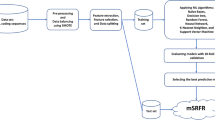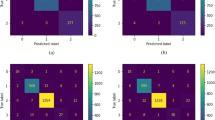Abstract
Biological classification based on gene codon sequence is critical in life science research. This paper aims to improve the classification performance of conventional algorithms by integrating bacterial foraging optimization (BFO) into the classification process. To enhance the searching capability of conventional BFO, we leverage adaptive T-distribution variation to optimize the swimming step size of BFO, which is named TBFO. Different degree of freedom for t-distribution was used according to the iteration process thus to accelerate converging speed of BFO. The parameters of Artificial Neural Network and Random Forest are then optimized through the TBFO thus to enhance the classification accuracy. Comparative experiment is conducted on six standard data set of DNA codon usage frequencies. Results show that, TBFO performs better in terms of accuracy and convergence speed than PSO, WOA, GA, and BFO.
Access this chapter
Tax calculation will be finalised at checkout
Purchases are for personal use only
Similar content being viewed by others
References
Diao, S.F.: The central dogma and the development of modern biology. Dialectics Nat. 51–5 (2000)
Chen, Y.Z., Li, X.Y., Wu, J.L., Hu, J., Liu, Y.Y., Ye, X.Y.: Codon preference and characteristics of the genes highly expressed in flammulina filiformis. Mycosystema, 1–14 (2022)
Song, W.Y.: Microorganisms and their biological classification. Hubei Educ. 72–5 (2019)
Gao, L.Y.: Artificial intelligence helps biologists classify tiny organisms. Knowl. Mod. Phys. 33(04), 66 (2022)
Bian Z.K.: Class-aware based KNN classification method. 34(10), 873–84 (2021)
Dong, H.Y.: A review of random forest optimization algorithms. 33(17), 34–7 (2021)
Wang, J.M.: Research on improvement of Naive Bayes classification algorithm: Harbin Univ. of Sci. Technol. (2021)
Wang, X., Shen, B.G., Guo, R.Z.: Improved ID3 decision tree algorithm induced by neighborhood equivalence. 21(09), 17–20 (2021)
Aliakbari Sani, S., Khorram, A., Jaffari, A., Ebrahimi, G.: Development of processing map for InX-750 superalloy using hyperbolic sinus equation and ANN model. Rare Met. 40(12), 3598–3607 (2018). https://doi.org/10.1007/s12598-018-1043-9
Li, C., Huang, W., Sun, W., Hao, H.: An association method for mulisource date based on SVM classification telecommunications technology, 1–4
Hu, X.M., Xie, Y., Jiang, H.F.: Prediction of breast cancer based on Penaltized logistic regression. Data Acquisition Process. 36(06), 1237–1249 (2021)
Zhang, C.S., Mao, H.: Prediction model for tap water coagulation dosing based on BPNN optimized with BFO. Chin. Environ. Sci. 41(10), 4616–4623 (2021)
Gong, R.K.: WSN node coverage optimization based on improved PSO-BFO algorithm. J. North China Univ. Sci. Technol. (Nat. Sci. Ed.) 43(04), 52–59 (2021)
Wan, J.J.: Reliability evaluation of distribution network based on WOA optimized LSTM neural network. Intell. Comput. Appl. 11(10), 107–112 (2021)
Xu, Z.G.: Research on Feature Selection Based on Heuristic Algorithm: Zhejiang University (2020)
Huang, Z.Z.: Optimization of outbound contrainer space assignment in automated container terminals based on hyper-heuristic. Comput. Integr. Manuf. Syst.1–26 (2021)
Wu, L.Q., Li, Y.Y., Chen, S.T.: Power optimization of EPS system based on improved BFO algorithm. Sens. Microsyst. 40(08), 61–64 (2021)
Xing, D.F., Xue, S.R., Chen, G.W., Shi, J.Q.: Outdoor equipment fault detection based on improved bacterial algorithm. Comput. Simul. 38(08), 157–161 (2021)
Zhang, W.K., Liu, S.: Improved sparrow search algorithm based on adaptive t -distribution and golden sine and its application. Microelectron. Comput. 1–8 (2021)
Miodrag, Z.: COVID-19 cases prediction by using hybrid machine learning and beetle antennae search approach. ScienceDirect 6707 (2021). https://doi.org/10.1016/j.scs.2020.102669
Fatemeh, H., et al: Computing optimal discrete readout weights in reservoir computing is NP-hard. ScienceDirect, 233–236 (2019). https://doi.org/10.1016/j.neucom.2019.02.009, ISSN 0925-2312
Bezdan, T., et al.: Hybrid fruit-fly optimization algorithm with K-means for text document clustering. Mathematics 9, 1929 (2021). https://doi.org/10.3390/math9161929
Bacanin, N., et al.: Artificial neural networks hidden unit and weight connection optimization by quasi-refection-based learning artificial bee colony algorithm. IEEE Access 9, 169135–169155 (2021). https://doi.org/10.1109/ACCESS.2021.3135201
Han, F.F., Liu, S.: Adaptivesatin bower bird optimization algorithm based on adaptive Tdistribution mutation. Microelectron. Comput. 35(08), 117–121 (2018)
Nakamura, Y.: Codon usage tabulated from international DNA sequence databases: status for the year 2000. Nucleic Acids Res. 28, 292 (2000)
Acknowledgement
This study is supported by Natural Science Foundation of Guang-dong (2022A1515012077), Shenzhen Higher Education Support Plan (20200826144104001).
Author information
Authors and Affiliations
Corresponding author
Editor information
Editors and Affiliations
Rights and permissions
Copyright information
© 2022 Springer Nature Switzerland AG
About this paper
Cite this paper
Yang, S., Xu, Z., Zou, C., Liang, G. (2022). T-Distribution Based BFO for Life Classification Using DNA Codon Usage Frequencies. In: Tan, Y., Shi, Y., Niu, B. (eds) Advances in Swarm Intelligence. ICSI 2022. Lecture Notes in Computer Science, vol 13345. Springer, Cham. https://doi.org/10.1007/978-3-031-09726-3_30
Download citation
DOI: https://doi.org/10.1007/978-3-031-09726-3_30
Published:
Publisher Name: Springer, Cham
Print ISBN: 978-3-031-09725-6
Online ISBN: 978-3-031-09726-3
eBook Packages: Computer ScienceComputer Science (R0)




